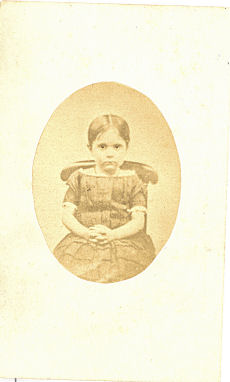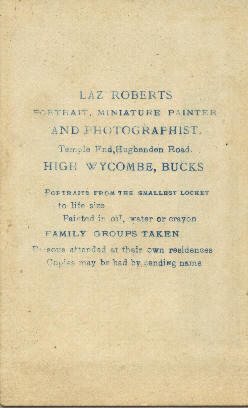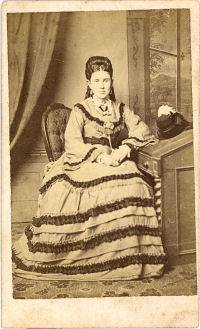|
Hertfordshire Postcard Artists, Photographers, Publishers, etc. Laz Roberts circa 1870 of High Wycombe & St Albans |
I scan eBay for interesting low-cost items which could make an interesting story on this web site and the following item caught my eye.
A Google search quickly brought up these following information - including a carte de visite with a virtually identical back - datable to 1869 - and with a High Wycombe address.
|
Laz Roberts at High Wycombe - from the Web |
||||||||||
|
The competition increased further when Laz Roberts advertised in the Bucks Free Press of 23 October 1868, further reducing the price for CdV's to 3s.6d (17.5p) per dozen. At this time he was operating from Hughenden Road, Frogmoor Gardens, but early in 1870 he moved his business to 85 Easton St. He placed an advert in the Bucks Free Press on 16 March to say that he was applying for permission to move, and then on 29 March announcing that he had moved, and was now open for business. Later in the year, on 2 September, he advertised that ‘’he is working on entirely new process of his own, Chromophotography, and taking life-like CdVs in Natural Colours’’. The last we hear of Laz Roberts is in 1875 when he advertised in Judson’s Trade Directory. From Early Professional Photographers in High Wycombe, 1869-1977 |
|||||||||
The brief biography included the words "he is working on entirely new process of his own, Chromophotography, and taking life-like CdVs in Natural Colours" in 1870 - and if this was the case this he would be a significant pioneer photographer, who had not been properly recorded (or else I would have found much more on Google). It is important to realise that in 1870 photographic plates had very little sensitivity to green light, and virtually none to red light. The relevant Wikipedia account on Colour photography reads:
As long as photographic materials were usefully sensitive only to blue-green, blue, violet and ultraviolet, three-color photography could never be practical. In 1873 German chemist Hermann Wilhelm Vogel discovered that the addition of small amounts of certain aniline dyes to a photographic emulsion could add sensitivity to colors which the dyes absorbed. He identified dyes which variously sensitized for all the previously ineffective colors except true red, to which only a marginal trace of sensitivity could be added. In the following year, Edmond Becquerel discovered that chlorophyll was a good sensitizer for red. Although it would be many more years before these sensitizers (and better ones developed later) found much use beyond scientific applications such as spectrography, they were quickly and eagerly adopted by Louis Ducos du Hauron, Charles Cros and other color photography pioneers. Exposure times for the "problem" colors could now be reduced from hours to minutes. As ever-more-sensitive gelatin emulsions replaced the old wet and dry collodion processes, the minutes became seconds. New sensitizing dyes introduced early in the 20th century eventually made so-called "instantaneous" color exposures possible.
In the circumstances I thought I would try and find out more about Laz Roberts, and Chromophotography, and the resulting partial time line is given below.
There was no great difficulty in finding him in the censuses between 1841 and 1871. His father, Lazarus Roberts was a miniature/portrait painter and he was described as an artist (1853), colorer of photographs (1861) and portrait painter and photographist (1871). What happened to him after that? He was not with the family in 1881, (although the last child was born in 1879) and in 1891 his widow remarried. He had 13 children - Fanny; Richard; Sarah; Mary; William; Anne; James; Alice; Minnie; Arthur, Robert, Martha and Emily - and to try and find evidence of what he was doing I tracked down most of them (only relevant links shown below). This was complicated because the places of birth in some censuses were given incorrectly. His (former) occupation was described as an artist in 1874, 1882, 1887, 1899 & 1902 and as photographer in 1895. I found no evidence that any of the children were involved in photography.
So what was "Chromophotography"? It is clear from what is known of his career that he was an artist who would have produced coloured CDV by painting on photographs, and this is supported by the wording on the backs of the examples of his work shown above. I found the following definition on Wikipedia:
Chromophotography is a technique, somewhere between painting and photography, which evolved in the second half of the 19th century. Firstly, two prints of the photograph were made. One was hand-painted with very bright colours; the other was painted in paler colours, and then made translucent by applying wax to the paper. The second picture was then superimposed over the first, with a small air gap in between, resulting in a three-dimensional effect. This technique was used by only a very few photographers, mostly in Central Europe.
In Bohemia, (now Czech Republic), one of the best known exponents of this technique was Alexander Seik.
In New Zealand, Gisborne photographer C P Browne, advertised Chromo Photography in 1883.Poverty Bay Herald, Volume XI, Issue 4014, 17 June 1884, Page 3
It might appear that Laz Roberts was one of the few photographers (perhaps the first) to pioneer the Bohemian technique in England. However perhaps he was not talking about the technique invented in Europe at all. A search of the British Newspaper Archives reveals several relevant references. Messers Porter and Cann were advertising "Chromo-Photographic Portraiture" in the Bury and Norwich Post of 2nd August 1854, which clearly relates to painting colour on photographs and by 1856 several photographers were using the term in their adverts, although this use did not catch on.. This pre-dates by 8 years the first reference to the new invention called "chromo-photography" by M. Albert, photographer to the Court in Munich reported in the South London Chronicle of 10 May 1862. The term "Chromo-photography" was also used to describe a very different photographic technique using chromic acid described in Dr. Hermann Vogel's book The Chemistry of Light and Photography as reviewed in The Examiner of 24 July 1875. In 1882 and 1883 adverts appeared in the press where shops specialising in drawing and painting materials referred to materials for "Chromo-photography" but there is nothing in the advertisements to suggest that this involved anything more than the commonplace tinting of photographs.
It would be interesting to know if any examples of Laz Roberts' chromophotographs survive.









